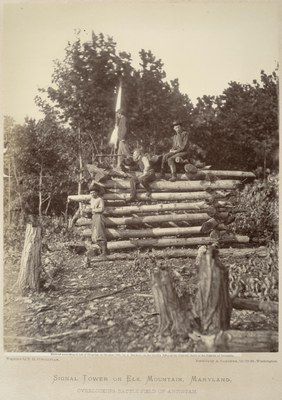
Plan your visit
Our (FREE) parking lot is located on New York Street a ½ block east of West Street. Free parking with admission.
Gardner’s Photographic Sketch Book of the War

Alexander Gardner’s Photographic Sketch Book of the War is known as one of the most important visual records documenting the Civil War. This two-volume set from 1865 includes 100 albumen photographs depicting battle sites, forts, military structures and other sites during the war. The Indiana Historical Society’s copy of Gardner’s two-volume set was in good condition except for a few issues that prevented safe handling. There were two detached pages in the first volume and numerous small tears throughout both. If left alone, handling the books could have sped up deterioration over time. Fortunately, the treatment needed to fix these problems was simple and could be accomplished with minimal intervention into the original structure of the books.
First, we pasted the detached pages in the first volume together along the spine edge with a thin line of glue just as it was when the book was originally constructed. This line of glue is called a “tip line.” The reattachment was simple because the two pages could be reattached as a single unit. Fortunately, the old tip line was narrow enough that it wasn’t causing structural damage when the pages were flexed, therefore it could be left undisturbed, simplifying the treatment even further.
Then we used Japanese paper with wheat starch paste to reattach the pages to their original stub at the tear point. We also adhered a narrow strip to the front and back of the tear to provide support while the pages are turned. Japanese paper is very thin and flexible, but extremely strong at the same time. This creates an almost invisible mend while providing enough structural support to the tear. The rest of the tears scattered throughout both volumes were “overlapping tears” and were fairly small. These types of tears can be repaired without adding Japanese paper and can be re-adhered with wheat starch paste using the pages’ original fibers. The mends virtually disappear once dry.
The books are once again structurally sound and ready to be carefully consulted. We did not address the foxing stains throughout the books, because treatment would require taking the books completely apart. The bindings are in excellent condition, and it is better to not disturb them at this point and perform only minimal repairs if needed.
The conservation treatment was funded by a donation from the 19th United States Regular Infantry, 1st Battalion Company A, Living History Unit.








